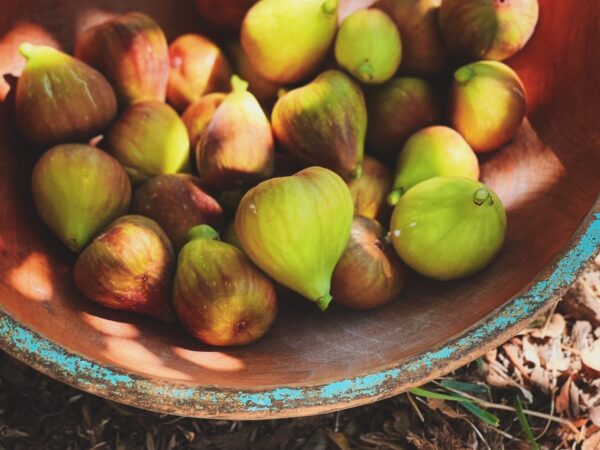by Louise Ayer
When the figs are ripe, they are ripe, and there is no denying them. On Cape Cod we have this particular purple fig that starts producing gorgeous ripe fruit towards the end of August. We brought this fig from our house in Connecticut. The tree was a baby at the time. We chose a spot for it south of the dining room where it got lots of sun and protection from the northeast winds that roll across Little Pleasant Bay in winter. Growing figs on The Cape is pushing it a bit, but this was such a protected spot we decided to take the chance. For two years it didn’t do much, just sat there and grew, but produced no fruit. We wrapped it lovingly with burlap to further protect it. The third year it produced fruit but too late to harvest before the cold set in. The tree started to get quite big. We pruned some of the branches in the center of the tree to let in more sun so it might produce ripe fruit earlier, which worked. Last year we got lots of fruit in August and thoroughly enjoyed them.
This year we even got a small spring crop that was ready in July and a large fall crop. Thank goodness my son Austin and his girlfriend Amanda came to visit and work during the three-week period from late August to early September, when the bulk of the figs were ripe. Each day we would all go out to harvest blackberries, raspberries, cherry tomatoes, okra, peppers, eggplant, herbs, and lots of figs. This purple fig is now close to eight feet tall. We can’t reach the ones at the top, but Austin is 6’4” and he can. Each morning I would peek out the mudroom window from which I had a good view to see the full, luscious, purple fruits that were slightly drooping on their stems, a sure sign that they were ready, a whole new bunch from the 20 or 30 that Amanda and I had picked the day before. Austin would go out with his basket and come back with okra, fat eggplants, and 30 or 40 figs.
We can eat quite a few figs but not 20 to 40 a day! I dehydrated a significant number of the figs in my oven on a wire rack on a cookie sheet at 135°F for 8 hours, which worked like a charm. These dried figs are destined to become fig newtons. Quite a few of the figs I gave away to family and friends, but the rest I turned into fig spread which I then canned to give away as gifts and for us to happily eat as the temperature drops and the snow begins to fly.
Ingredients:
1 pound ripe purple figs, stemmed and cut into quarters
Rind of 1 lemon peeled from the lemon with vegetable peeler in strips
Juice of one lemon
1 teaspoon ground cardamom
1 teaspoon dried thyme or 2 teaspoons fresh thyme
½ cup granulated sugar or ½ cup coconut palm sugar
2 tablespoons maple syrup
Put the cut figs in a heavy bottomed saucepan and add all the rest of the ingredients. Bring the fig mixture to a boil on medium high, stirring frequently. Once boiling, reduce heat to a fast simmer and cook for 40 minutes while stirring a little less frequently. When mixture gets thick, put it in clean jars and store in the fridge, or put in sterile jars and put them in a water bath canner for 10 minutes. Then you can store the fig spread in a cool dark place for a year or more. Make sure you label and date the jars.
You can double this recipe, but I wouldn’t do more than that in one pot. Most jams and jellies do better if made in relatively small batches.
Fig spread is yummy on crackers with goat cheese.

 Get access to the monthly Rehumanization Magazine featuring contributors from the front lines of this effort—those living on Death Row, residents of the largest women’s prison in the world, renowned ecologists, the food insecure, and veteran correctional officers alike.
Get access to the monthly Rehumanization Magazine featuring contributors from the front lines of this effort—those living on Death Row, residents of the largest women’s prison in the world, renowned ecologists, the food insecure, and veteran correctional officers alike.